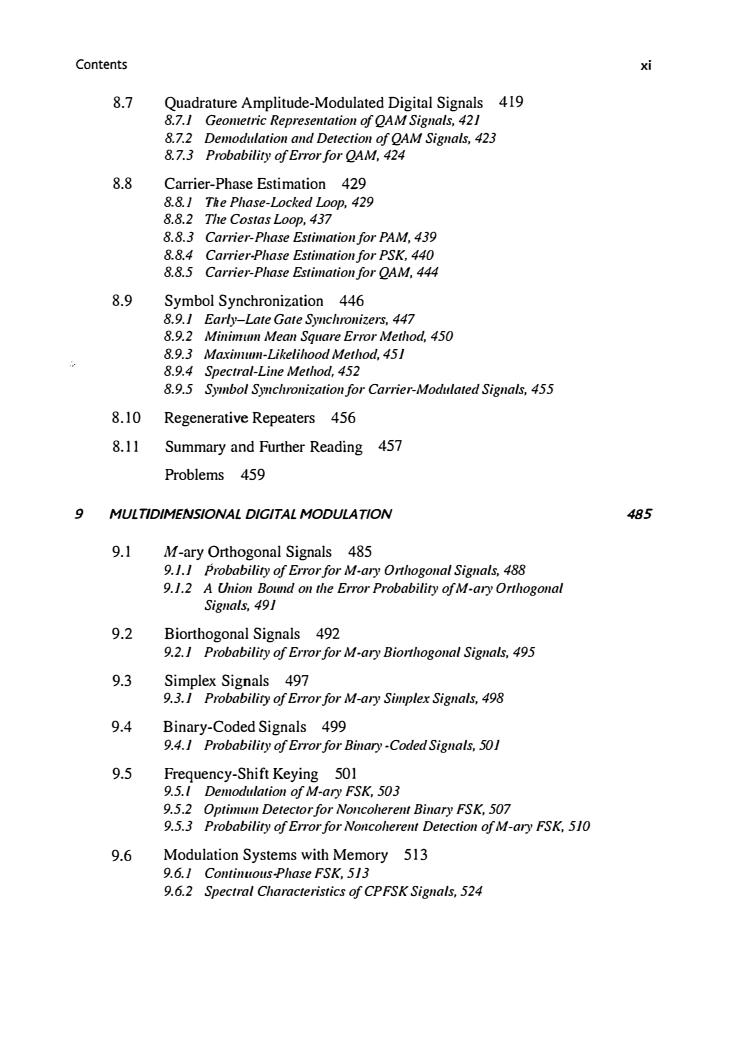正在加载图片...

Contents xi 8.7 Quadrature Amplitude-Modulated Digital Signals 419 8.7.1 Geometric Representation of QAM Signals,421 8.7.2 Demodulation and Detection of OAM Signals,423 8.7.3 Probability of Error for QAM,424 8.8 Carrier-Phase Estimation 429 8.8.1 The Phase-Locked Loop,429 8.8.2 The Costas Loop,437 8.8.3 Carrier-Phase Estimation for PAM,439 8.8.4 Carrier-Phase Estimation for PSK,440 8.8.5 Carrier-Phase Estimation for OAM,444 8.9 Symbol Synchronization 446 8.9.1 Early-Late Gate Synchronizers,447 8.9.2 Minimtmn Mean Square Error Method,450 8.9.3 Maximum-Likelihood Method,451 8.9.4 Spectral-Line Method,452 8.9.5 Symbol Synchronization for Carrier-Modulated Signals,455 8.10 Regenerative Repeaters 456 8.11 Summary and Further Reading 457 Problems 459 9 MULTIDIMENSIONAL DIGITAL MODULATION 485 9.1 M-ary Orthogonal Signals 485 9.1.1 Probability of Error for M-ary Orthogonal Signals,488 9.1.2 A Union Bound on the Error Probability of M-ary Orthogonal Signals,491 9.2 Biorthogonal Signals 492 9.2.1 Probability of Error for M-ary Biorthogonal Signals,495 9.3 Simplex Signals 497 9.3.1 Probability of Error for M-ary Simplex Signals,498 9.4 Binary-Coded Signals 499 9.4.1 Probability of Error for Binary-Coded Signals,501 9.5 Frequency-Shift Keying 501 9.5.1 Demodulation of M-ary FSK,503 9.5.2 Optimumn Detector for Noncoherent Binary FSK,507 9.5.3 Probability of Error for Noncoherent Detection of M-ary FSK,510 9.6 Modulation Systems with Memory 513 9.6.1 Continuous-Phase FSK,513 9.6.2 Spectral Characteristics of CPFSK Signals,524Contents 9 8.7 Quadrature Amplitude-Modulated Digital Signals 419 8.7.1 Geo111etric Represe11tation of QAM Signals, 421 8.7.2 De1110.d11latio11 and Detection of QAM Signals, 423 8. 7.3 Probability of Error/or QAM, 424 8.8 Carrier-Phase Estimation 429 8.8. I Tile Phase-Locked Loop, 429 8.8.2 Tile Costas Loop, 437 8.8.3 Carrier- Phase Esti111atio11 for PAM, 439 8.8.4 Carrier-Phase Estilnation for PSK, 440 8.8.5 Carrier-Phase Esti111ation for QAM, 444 8.9 Symbol Synchronization 446 8.9.1 Early-Late Gate Sy11chro11izers, 447 8.9.2 Mini11111111 Mean Square Error Method, 450 8.9.3 Maxilnu111-Likelihood Method, 451 8.9.4 Spectral-Line Method, 452 8.9.5 Sy111bol Synchronization for Carrier-Modulated Sig11als, 455 8.10 Regenerative Repeaters 456 8.11 Summary and Further Reading 457 Problems 459 MUL T/DIMENSIONAL DIGITAL MODULA T/ON 9 .1 M -ary Orthogonal Signals 485 9.1.1 Probability of Error for M-ary Orthogonal Signals, 488 9.1.2 A Union Bound on the Error Probability of M-a1y Orthogonal Signals, 491 9.2 Biorthogonal Signals 492 9.2.1 Probability of Envr for M-a1y Biorthogonal Signals, 495 9.3 Simplex Signals 497 9.3.1 Probability of Error for M-ary SiJnplex Signals, 498 9.4 Binary-Coded Signals 499 9.4.1 P1vbability of Error for Bina1y-Coded Signals, 501 9.5 Frequency-Shift Keying 501 9.5. l Den1odulation of M-ary FSK, 503 9.5.2 Opti1111on Detector for Noncoherent Binary FSK, 507 9.5.3 Probability of Error for Noocoherent Detection of M-a1y FSK, 510 9.6 Modulation Systems with Memory 513 9.6.J Continuous-Phase FSK, 513 9.6.2 Spectral Characteristics of C PFSK Signals, 524 xi 485